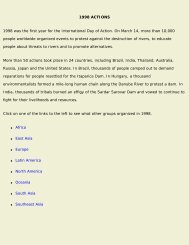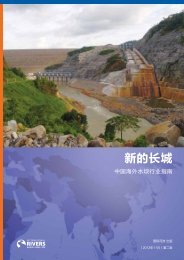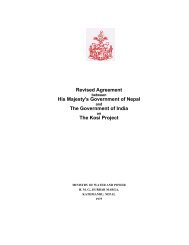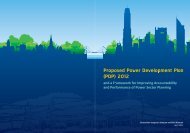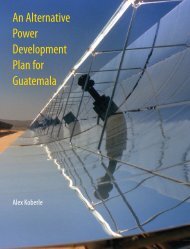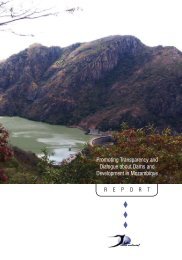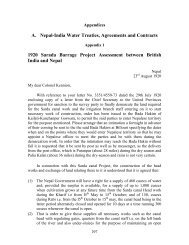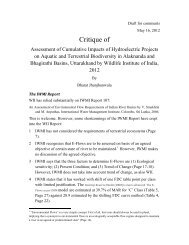Mountains of Concrete - International Rivers
Mountains of Concrete - International Rivers
Mountains of Concrete - International Rivers
Create successful ePaper yourself
Turn your PDF publications into a flip-book with our unique Google optimized e-Paper software.
Responses <strong>of</strong> Civil Society andAffected People’s GroupsPakistan, Nepal and India all have a very active and vigilant civil society and media, though the intensity <strong>of</strong> their workrelated to big dams differs. (The same cannot be said for Bhutan.) In all three countries, there are organisations<strong>of</strong> dam affected people, advocacy and research groups and others that have been raising important issues relatedto dams in the larger context <strong>of</strong> just and sustainable development. As a result, there is a rich critique <strong>of</strong> dams anddevelopment in these countries. There have been several attempts, especially in India, to locate a critique <strong>of</strong> big damsin the larger context <strong>of</strong> electricity and energy planning <strong>of</strong> the country.Dams are highly controversial and contentious and thedebate around them has <strong>of</strong>ten been polarising. There is avocal population in these countries who do support bigdams; this support is <strong>of</strong>ten expressed in the media. This viewequates dams with development and argues that dams arenecessary for meeting electricity needs. These argumentsare <strong>of</strong>ten presented as assertions and viable alternativesare overlooked. Social and environmental impacts areignored or categorized as the necessary price to be paid fordevelopment. Severe electricity shortages in these countriesreinforce the case for large dams in the public discourse.While all this has been replicated in the context <strong>of</strong> theHimalayan dams, these projects have also presented newissues and new challenges. Cultural issues have becomevery important. For example, several organizations <strong>of</strong>affected people are strongly protesting dams in Sikkimand Arunachal Pradesh in India on the issue <strong>of</strong> identityand culture. On June 12, 2008, the government <strong>of</strong> Sikkimannounced the scrapping <strong>of</strong> four projects – 90 MW Ringpi,33 MW Rukel, 120 MW Lingza and 141 MW Rangyongproject – in response to the struggle <strong>of</strong> the Affected Citizens<strong>of</strong> Teesta. 142Projects being built for exporting electricity fromNepal to India have prompted people to raise the issue <strong>of</strong>rights to resources and to challenge the export <strong>of</strong> water andenergy resources when the country itself faces severe energyand electricity shortages.Some experts argue that the idea that Nepal has surpluselectricity to export to India is itself fallacious. It is a myopicvision that makes Nepal import oil and export electricity.If Nepal increasingly uses electricity for transportation,production processes and other uses, replacing oil, then notonly will Nepal become self-sufficient in energy but willnot have any surplus power to sell to India.Of course, this does not necessarily imply thatNepal should build big dams, for they have serious social,environmental and other impacts. The point made here isthat Nepal needs its energy sources for meeting its ownrequirements. The development <strong>of</strong> these sources shouldbe through small and medium projects, and based oncomprehensive assessments <strong>of</strong> all costs and benefits forchoosing the optimal solutions, as groups like WAFED, 143a national network <strong>of</strong> water and energy project affectedpeople and local concerned groups in Nepal, are demanding.Even in these projects, they are calling for the involvement<strong>of</strong> local people, making them partners and ensuring thatthey have first rights to benefit sharing. All <strong>of</strong> this should bein place before projects are considered.In general, civil society groups and affected peoplehave been raising several important issues and questions.Will these dams meet the energy needs <strong>of</strong> the countries,especially the needs <strong>of</strong> people without electricity access,the poor, the vulnerable? Are these dams the best or theoptimal solution? This is by no means established and is afundamental question being raised.Various groups are calling for assessments to understandthe full impacts <strong>of</strong> this massive dam building, especially thecumulative impacts. Some other key demands <strong>of</strong> civil societygroups and affected people include the incorporation<strong>of</strong> social and environmental impacts as equal criteria indecision-making, and making local people, especiallyaffected people, meaningful participants in the dam-relateddecision-making processes.One <strong>of</strong> the most interesting features <strong>of</strong> the region isthat such groups are forming links and networks acrossboundaries. This is an important recognition <strong>of</strong> the fact thatthe region is highly interconnected, both geographicallythrough its shared rivers, and culturally and socially throughthe many interactions between common citizens. Groupsfrom all the countries have expressed the desire to strengthensuch links and networks. This is very important for countrieslike Nepal and India, where the Indian government andIndian companies are building dams in Nepal for the export<strong>of</strong> electricity to India. Ordinary citizens in Nepal <strong>of</strong>tenM o u n ta i n s o f C o n c r e t e : D a m B u i l d i n g i n t h e H i m a l aya s | 37




